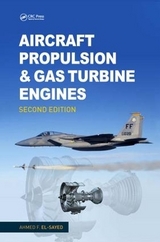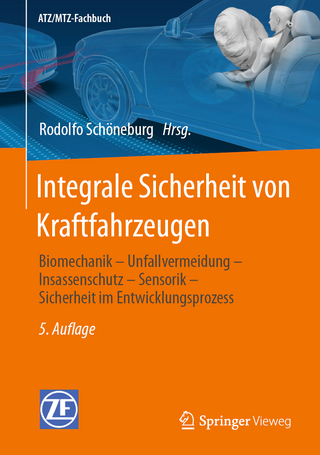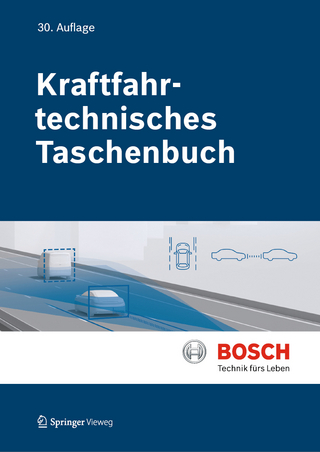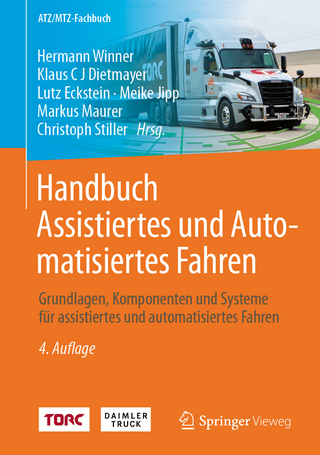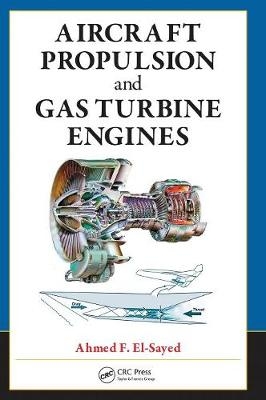
Aircraft Propulsion and Gas Turbine Engines
Crc Press Inc (Verlag)
978-0-8493-9196-5 (ISBN)
- Titel erscheint in neuer Auflage
- Artikel merken
The escalating use of aircraft in the 21st century demands a thorough understanding of engine propulsion concepts, including the performance of aero engines. Among other critical activities,gas turbines play an extensive role in electric power generation, and marine propulsion for naval vessels and cargo ships.
In the most exhaustive volume to date, this text examines the foundation of aircraft propulsion: aerodynamics interwoven with thermodynamics, heat transfer, and mechanical design. With a finely focused approach, the author devotes each chapter to a particular engine type, such as ramjet and pulsejet, turbojet, and turbofan. Supported by actual case studies, he illustrates engine performance under various operating conditions.
Part I discusses the history, classifications, and performance of air breathing engines. Beginning with Leonardo and continuing on to the emergence of the jet age and beyond, this section chronicles inventions up through the 20th century. It then moves into a detailed discussion of different engine types, including pulsejet, ramjet, single- and multi-spool turbojet, and turbofan in both subsonic and supersonic applications.
The author discusses Vertical Take Off and Landing aircraft, and provides a comprehensive examination of hypersonic scramjet and turbo ramjet engines. He also analyzes the different types of industrial gas turbines having single-and multi-spool with intercoolers, regenerators, and reheaters.
Part II investigates the design of rotating compressors and turbines, and non-rotating components, intakes, combustion chambers, and nozzles for all modern jet propulsion and gas turbine engine systems, along with their performance. Every chapter concludes with illustrative examples followed by a problems section; for greater clarity, some provide a listing of important mathematical relations.
Part I Aero Engines and Gas Turbines
Chapter 1 History and Classifications of Aero Engines . . . 3
1.1 Prejet Engines—History 4
1.1.1 Early Activities in Egypt and China 4
1.1.2 Leonardo da Vinci . .. ... .5
1.1.3 Branca’s Stamping Mill . . . 5
1.1.4 Newton’s SteamWagon . . . 6
1.1.5 Barber’s Gas Turbine . .. 6
1.1.6 Miscellaneous Aero-Vehicles’Activities in the Eighteenth and Nineteenth
Centuries . .. . 7
1.1.7 TheWright Brothers . .. . 8
1.1.8 Significant Events up to 1940s . .. 10
1.1.8.1 Aero-Vehicle Activities . . 10
1.1.8.2 Reciprocating Engines . . . 12
1.2 Jet Engines . . . . 13
1.2.1 Jet Engine Inventors: Dr. Hans von Ohain and Sir FrankWhittle . . 13
1.2.1.1 Sir Frank Whittle (1907–1996) . .. 13
1.2.1.2 Dr. Hans von Ohain (1911–1998) . . . 14
1.2.2 Turbojet Engines. .. .. 15
1.2.3 Turboprop and Turboshaft Engines . 18
1.2.4 Turbofan Engines . .. .21
1.2.5 Propfan Engine 23
1.2.6 Pulsejet, Ramjet, and Scramjet Engines . .. . . 24
1.2.6.1 Pulsejet Engine . .. .. 24
1.2.6.2 Ramjet and Scramjet Engines . .. . 25
1.2.7 Industrial Gas Turbine Engines . .27
1.3 Classifications of Aerospace Engines . .. . . 28
1.4 Classification of Jet Engines. .. . . 29
1.4.1 Ramjet. .. .29
1.4.2 Pulsejet . .. . . . 30
1.4.3 Scramjet . .. . . 31
1.4.4 Turboramjet . . . . 31
1.4.5 Turborocket . . . . 32
1.5 Classification of Gas Turbine Engines . .. . 32
1.5.1 Turbojet Engines. .. .. 33
1.5.2 Turboprop . .. 34
1.5.3 Turboshaft. .. 35
1.5.4 Turbofan Engines . .. .37
1.5.5 Propfan Engines . .. .. 41
1.5.6 Advanced Ducted Fan . .42
1.6 Industrial Gas Turbines . 43
1.7 Non–Air-Breathing Engines . .. . . 44
1.8 Future of Aircraft and Power Plant Industries . .. .. 44
Closure . . . . 52
Problems . . 52
References 54
Chapter 2 Performance Parameters of Jet Engines . .. . . . 57
2.1 Introduction . . . 57
2.2 Thrust Force . . . 57
2.3 Factors Affecting Thrust 67
2.3.1 Jet Nozzle . .. 67
2.3.2 Air Speed . .. . 68
2.3.3 Mass Air Flow . 68
2.3.4 Altitude . .. . . . 68
2.3.5 Ram Effect . .69
2.4 Engine Performance Parameters . . . 70
2.4.1 Propulsive Efficiency . .. 70
2.4.2 Thermal Efficiency . .. . . 75
2.4.3 Propeller Efficiency. .. . . 76
2.4.4 Overall Efficiency . .. . . . 77
2.4.5 Takeoff Thrust . 80
2.4.6 Specific Fuel Consumption . .. . . . 81
2.4.7 Aircraft Range . 82
2.4.8 Range Factor . . . 85
2.4.9 Endurance Factor . .. .85
2.4.10 Specific Impulse . .. .. 87
Problems . . 91
References 94
Chapter 3 Pulsejet and Ramjet Engines . .. . . . 97
3.1 Introduction . . . 97
3.2 Pulsejet Engines. .. . . . 97
3.2.1 Introduction . . . . 97
3.2.2 Valved Pulsejet 98
3.2.3 Valveless Pulsejet. .. .102
3.2.4 Pulse Detonation Engine . . 103
3.3 Ramjet Engines . .. . . . 106
3.3.1 Ideal Ramjet . . . 107
3.3.2 Real Cycle . .110
3.4 Case Study. .129
3.5 Summary and Governing Equations for ShockWaves and Isentropic Flow . .. .. 141
3.5.1 Summary . .. . 141
3.5.2 Normal ShockWave Relations . .141
9196: “chap00” — 2007/11/27 — 18:19 — page ix — #9
3.5.3 Oblique ShockWave Relations . .142
3.5.4 Rayleigh-Flow Equations . .. .. 142
3.5.5 Isentropic Relation . .. . . 142
Problems . . 143
References 145
Chapter 4 Turbojet Engine . 147
4.1 Introduction . . . 147
4.2 Single Spool . . . 149
4.2.1 Examples of Engines . .. 149
4.2.2 Thermodynamic Analysis . .. .. 150
4.2.3 Ideal Case . .. 150
4.2.4 Actual Case . . . . 165
4.2.5 Comparison Between Operative and Inoperative Afterburner . .. . 175
4.3 Two-Spool Engine . .. 178
4.3.1 Nonafterburning Engine. . . 179
4.3.1.1 Example of Engines . .. 179
4.3.2.2 Thermodynamic Analysis 180
4.3.3 Afterburning Engine . .. . 183
4.3.3.1 Examples for Two-Spool Afterburning Turbojet Engines . .. .183
4.3.2.2 Thermodynamic Analysis 184
4.4 Statistical Analysis . .. 188
4.5 Thrust Augmentation . . . 189
4.5.1 Water Injection 189
4.5.2 Afterburning . . . 190
4.5.3 Pressure Loss in Afterburning Engine . .. .191
4.6 Supersonic Turbojet . .195
4.7 Optimization of the Turbojet Cycle . .. .198
Problems . . 209
References 213
Chapter 5 Turbofan Engines . .. .. 215
5.1 Introduction . . . 215
5.2 Forward Fan Unmixed Single-Spool Configuration. .216
5.3 Forward Fan Unmixed Two-Spool Engines . 221
5.3.1 The Fan and Low-Pressure Compressor on One Shaft. . . 221
5.3.2 Fan Driven by the LPT and the Compressor Driven by the HPT . . . 232
5.3.3 A Geared Fan Driven by the LPT and the Compressor Driven
by the HPT. .233
5.4 Forward Fan Unmixed Three-Spool Engine . 235
5.5 Forward Fan Mixed-Flow Engine . . 242
5.5.1 Mixed-Flow Two-Spool Engine . . . . 242
5.6 Mixed Turbofan with Afterburner . . 255
5.6.1 Introduction . . . . 255
5.6.2 Ideal Cycle . .256
5.6.3 Real Cycle . .258
5.7 AFT Fan . .. . 258
5.8 V/STOL. .. . . 261
5.8.1 Swiveling Nozzles . .. . . . 261
5.8.2 Switch-In Deflector System . .. . . . 266
5.9 Performance Analysis. . . 273
Summary. . 294
Problems . . 297
References 305
Chapter 6 Turboprop, Turboshaft, and Propfan Engines . . . 307
6.1 Introduction to Turboprop Engines . .. .307
6.2 Classification of Turboprop Engines . .. . . . 310
6.3 Thermodynamic Analysis of Turboprop Engines. .. . . 312
6.3.1 Single-Spool Turboprop . . . 312
6.3.2 Two-Spool Turboprop . .316
6.4 Analogy with Turbofan Engines. . . . 319
6.5 Equivalent Engine Power . .. .. 320
6.5.1 Static Condition320
6.5.2 Flight Operation . .. .. 320
6.6 Fuel Consumption . .. 320
6.7 Turboprop Installation . . 321
6.8 Performance Analysis. . . 329
6.9 Comparison Between Turbojet, Turbofan, and Turboprop Engines . .. .330
6.10 Turboshaft Engines . .333
6.11 Power Generated by Turboshaft Engines . . . . 334
6.11.1 Single-Spool Turboshaft . . 334
6.11.2 Double-Spool Turboshaft . .. .. 335
6.12 Examples for Turboshaft Engines . . 336
6.13 Propfan Engines. .. . . . 337
Summary of Turboprop Relations . .. . . . 340
Problems . . 340
References 344
Chapter 7 High-Speed Supersonic and Hypersonic Engines . .. . . . 345
7.1 Introduction . . . 345
7.2 Supersonic Aircraft and Programs . .. .. 345
7.2.1 Anglo-French Activities . . . 346
7.2.2 Russian Activities . .. .347
7.2.3 The U.S. Activities . .. . . . 347
7.3 Future of Commercial Supersonic Technology . .. .349
7.4 Technology Challenges of the Future Flight . 350
7.5 High-Speed Supersonic and Hypersonic Propulsion . . . . 350
7.5.1 Introduction . . . . 350
7.5.2 Hybrid Cycle Engine . .. 351
7.6 Turboramjet Engine . .352
7.7 Wraparound Turboramjet . .. .. 352
7.7.1 Operation as a Turbojet Engine . .352
7.7.2 Operation as a Ramjet Engine . .. 355
7.8 Over/Under Turboramjet . .. .. 356
7.8.1 Turbojet Mode . 358
7.8.2 Dual Mode . .358
7.8.3 Ramjet Mode . . 358
7.9 Turboramjet Performance . .. .358
7.9.1 Turbojet Mode . 358
7.9.2 Ramjet Mode . . 359
7.9.3 Dual Mode . .359
7.10 Case Study. .360
7.11 Examples for Turboramjet Engines . .. .365
7.12 Hypersonic Flight . .. . 367
7.12.1 History of Hypersonic Vehicles. .367
7.12.2 Hypersonic Commercial Transport . 369
7.12.3 Military Applications . .. 370
7.13 Scramjet Engines. .. . . 370
7.13.1 Introduction . . . . 370
7.13.2 Thermodynamics . .. .372
7.14 Intake of a Scramjet Engine . .. . . 372
7.15 Combustion Chamber. . . 373
7.16 Nozzle . .. . . . 376
7.17 Performance Parameters 376
Problems . . 380
References 383
Chapter 8 Industrial Gas Turbines . .385
8.1 Introduction . . . 385
8.2 Categories of Gas Turbines . .. . . . 386
8.3 Types of Industrial Gas Turbines . . . 387
8.4 Single-Shaft Engine. .388
8.4.1 Single Compressor and Turbine . . . . 389
8.4.1.1 Ideal Cycle. .. 389
8.4.1.2 Real Cycle . .. 392
8.4.2 Regeneration . . . 395
8.4.3 Reheat . .. .398
8.4.4 Intercooling . . . . 399
8.4.5 Combined Intercooling, Regeneration, and Reheat . .. 401
8.5 Double-Shaft Engine. . . . 406
8.5.1 Free Power Turbine . .. . . 406
8.5.2 Two Discrete Shafts (Spools) . .. . 408
8.6 Three Spool . . . 415
8.7 Combined Gas Turbine . 422
8.8 Marine Applications . . . . 423
8.8.1 Additional Components for Marine Applications . .. . . 424
8.8.2 Examples for Marine Gas Turbines . 426
8.9 Offshore Gas Turbines . . 427
8.10 Micro Gas Turbines (μ-Gas Turbines) . .. . 428
8.10.1 Microturbines versus Typical Gas Turbines . . . . 429
8.10.2 Design Challenges . .. . . . 429
8.10.3 Applications . . . . 430
Problems . . 431
References 433
Part II Component Design . .. .435
Chapter 9 Power Plant Installation and Intakes . 437
9.1 Introduction . . . 437
9.2 Power Plant Installation 437
9.3 Subsonic Aircraft. .. . . 437
9.3.1 Turbojet and Turbofan Engines . .438
9.3.1.1 Wing Installation . .. . . . 438
9.3.1.2 Fuselage Installation . .442
9.3.1.3 CombinedWing and Tail Installation (Three Engines) . . . 443
9.3.1.4 Combined Fuselage and Tail Installation . .444
9.3.2 Turboprop Installation . .444
9.4 Supersonic Aircraft . .446
9.4.1 Civil Transports 446
9.4.2 Military Aircrafts . .. .447
9.5 Air Intakes or Inlets . .448
9.6 Subsonic Intakes . .. . . 449
9.6.1 Inlet Performance . .. .451
9.6.2 Performance Parameters . . . 453
9.6.3 Turboprop Inlets . .. .. 457
9.7 Supersonic Intakes . .. 457
9.7.1 Review of Gas Dynamic Relations for Normal and Oblique Shocks . .. . . . 460
9.7.1.1 Normal ShockWaves . . . . 460
9.7.1.2 Oblique ShockWaves . . . . 461
9.7.2 External Compression Intake (Inlet) 462
9.7.3 Internal Compression Inlet (Intake) 467
9.7.4 Mixed Compression Intakes . .. . . 468
9.8 Matching Between Intake and Engine . .. . 470
9.9 Case Study. .472
Problems . . 475
References 479
Chapter 10 Combustion Systems. .. . . 481
10.1 Introduction . . . 481
10.2 Subsonic Combustion Chambers . . . 482
10.2.1 Tubular (or Multiple) Combustion Chambers . . 482
10.2.2 Tubo-Annular Combustion Chambers . .. .483
10.2.3 Annular Combustion Chambers. .484
10.3 Supersonic Combustion Chamber. . 485
10.4 Combustion Process . . . . 485
10.5 The Chemistry of Combustion . .487
10.6 Combustion Chamber Performance . .. .490
10.6.1 Pressure Losses 490
10.6.2 Combustion Efficiency . . . . 491
10.6.3 Combustion Stability . .. 491
10.6.4 Combustion Intensity . .. 492
10.7 Cooling . .. . . 493
10.8 Material . .. . . 495
10.9 Aircraft Fuels . . 496
10.10 Emissions and Pollutants . .. .. 497
10.10.1 Pollutant Formation . .. . 497
10.11 The Afterburner . .. . . . 498
10.12 Supersonic Combustion System. . . . 499
Problems . . 501
References 503
Chapter 11 Exhaust System . 505
11.1 Introduction . . . 505
11.2 Nozzle . .. . . . 507
11.2.1 Governing Equations . .. 508
11.2.1.1 Convergent–Divergent Nozzle . .. 508
11.2.1.2 Convergent Nozzle . .. . 511
11.2.2 Variable Geometry Nozzles . .. . . . 512
11.2.3 Afterburning Nozzles . .. 514
11.3 Calculation of the Two-Dimensional Supersonic Nozzle . .. . . . 517
11.3.1 Convergent Nozzle . .. . . 518
11.3.2 Divergent Nozzle . .. .522
11.3.2.1 Analytical Determination of the Contour of a Nozzle . . . . 525
11.3.2.2 Design Procedure for a Minimum Length Divergent Nozzle . .. 527
11.3.2.3 Procedure of Drawing the ExpansionWaves Inside the Nozzle . . . 528
11.4 Thrust Reversal . .. . . . 529
11.4.1 Classification of Thrust Reverser Systems . .531
11.4.2 Calculation of Ground Roll Distance . .. .. 536
11.5 Thrust Vectoring . .. . . 537
11.5.1 Governing Equations . .. 540
11.6 Noise. .. .. 541
11.6.1 Introduction . . . . 541
11.6.2 Acoustics Model Theory . . 543
11.6.3 Methods Used to Decrease the Jet Noise . .. . 544
Problems . . 547
References 548
Chapter 12 Centrifugal Compressors . . . 551
12.1 Introduction . . . 551
12.2 Layout of Compressor . . 553
12.2.1 Impeller . .. . . 553
12.2.2 Diffuser . .. . . 554
12.2.3 Scroll or Manifold . .. . . . 556
12.3 Classification of Centrifugal Compressors . . 556
12.4 Governing Equations . . . 559
12.4.1 The Continuity Equation . . 562
12.4.2 The Momentum Equation or Euler’s Equation for Turbomachinery . .. .562
12.4.3 The Energy Equation or the First Law of Thermodynamics . .. . . . 563
12.4.4 Slip Factor σ . . . 567
12.4.5 Prewhirl . .. . . 570
12.4.6 Types of Impeller . .. .581
12.5 Diffuser . .. . . 589
12.5.1 Vaneless Diffuser . .. .590
12.5.2 Vaned Diffuser. 592
12.6 Discharge Systems . .. 598
12.7 Characteristic Performance of a Centrifugal Compressor . .. . . 598
12.8 Erosion . .. . . 602
12.8.1 Introduction . . . . 602
12.8.2 Theoretical Estimation of Erosion . . 605
Problems . . 609
References 616
Chapter 13 Axial-Flow Compressors and Fans. . . 619
13.1 Introduction . . . 619
13.2 Comparison Between Axial and Centrifugal Compressors . .. . 621
13.2.1 Advantages of the Axial-Flow Compressor Over
the Centrifugal Compressor . .. . . . 621
13.2.2 Advantages of Centrifugal-Flow Compressor Over the Axial-Flow
Compressor . . . . 622
13.2.3 Main Points for Comparison Between Centrifugal and Axial Compressors . . 623
13.3 Mean Flow (Two-Dimensional Approach) . . 623
13.3.1 Types of Velocity Triangles . .. . . . 625
13.3.2 Variation of Enthalpy Velocity and Pressure of an
Axial Compressor . .. .627
13.4 Basic Design Parameters . .. .. 635
13.4.1 Centrifugal Stress . .. .635
13.4.2 Tip Mach Number . .. . . . 637
13.4.3 Fluid Deflection638
13.5 Design Parameters . .. 639
13.5.1 Degree of Reaction . .. . . 640
13.6 Three-Dimensional Flow . .. .. 642
13.6.1 Axisymmetric Flow. .. . . 643
13.6.2 Simplified Radial Equilibrium Equation . .. . 644
13.6.3 Free Vortex Method . .. . 646
13.6.4 General Design Procedure . .. .651
13.7 Complete Design Process for Compressor. . . 659
13.8 Rotational Speed (RPM) and Annulus Dimensions . .659
13.9 Determine Number of Stages (Assuming Stage Efficiency) . .. 662
13.10 Calculation of Air Angles for Each Stage at the Mean Section . . . 663
13.10.1 First Stage . .. 663
13.10.2 Stages from (2) to (n−1) . .. .. 664
13.10.3 Last Stage . .. 665
13.11 Variation of Air Angles from Root to Tip Based on the Type of Blading (Free
Vortex-Exponential-First Power) . . . 666
13.12 Blade Design . . 667
13.12.1 Cascade Measurements. . . . 667
13.12.2 Choosing the Type of Airfoil . .. . . 672
13.12.3 Stage Performance . .. . . . 672
13.12.3.1 Blade Efficiency and Stage Efficiency . .. . . 677
13.13 Compressibility Effects . 679
13.14 Performance . . . 687
13.14.1 Single Stage . . . . 687
13.14.2 Multistage Compressor . . . . 689
13.14.3 Compressor Map . .. .690
13.14.4 Stall and Surge . 691
13.14.5 Surge Control Methods. . . . 694
13.14.5.1 Multispool Compressor . . 694
13.14.5.2 Variable Vanes . . 694
13.14.5.3 Air Bleed. .. . . 695
13.15 Case Study. .701
13.15.1 Mean Section Data . .. . . 701
13.15.2 Variations from Hub to Tip . .. . . . 701
13.15.3 Details of Flow in Stage Number 2 . 703
13.15.4 Number of Blades and Stresses of the Seven Stages. .704
13.15.5 Compressor Layout . .. . . 705
13.16 Erosion . .. . . 708
13.17 Fouling . .. . . 712
Problems . . 714
References 725
Chapter 14 Axial Turbines. . . 727
14.1 Introduction . . . 727
14.2 Comparison Between Axial Flow Compressors and Turbines . . . . 729
14.3 Aerodynamics and Thermodynamics for a Two-Dimensional Flow . .. . . . 730
14.3.1 Velocity Triangles . .. . . . 730
14.3.2 Euler’s Equation . .. .. 732
14.3.3 Efficiency, Losses, and Pressure Ratio . .. . . . 734
14.3.4 Nondimensional Quantities . .. . . . 738
14.3.5 Several Remarks . .. .. 746
14.4 Three Dimensional . .. 752
14.4.1 Free Vortex Design . .. . . 753
14.4.2 Constant Nozzle Angle Design (α2) 753
14.4.3 General Case . . . 756
14.4.4 Constant Specific Mass Flow Stage 757
14.5 Preliminary Design . .772
14.5.1 Main Design Steps. .. . . . 772
14.5.2 Aerodynamic Design . .. 772
14.5.3 Blade Profile Selection . . . . 774
14.5.4 Mechanical and Structural Designs . 775
14.5.4.1 Centrifugal Stresses . .. 775
14.5.4.2 Centrifugal Stresses on Blades . .. 776
14.5.4.3 Centrifugal Stresses on Discs . .. . . 777
14.5.4.4 Gas Bending Stress . .. . 779
14.5.4.5 Centrifugal Bending Stress . .. .781
14.5.4.6 Thermal Stress . . 781
14.5.5 Turbine Cooling . .. .. 782
14.5.5.1 Turbine Cooling Techniques . .. . . . 782
14.5.5.2 Mathematical Modeling. . 784
14.5.6 Losses and Efficiency . .790
14.5.6.1 Profile Loss (Yp) . .. . . . 790
14.5.6.2 Annulus Loss . . . 791
14.5.6.3 Secondary Flow Loss . . . . 791
14.5.6.4 Tip Clearance Loss (Yk) . 792
14.6 Turbine Map. . . 793
14.7 Case Study. .797
14.7.1 Design Point . . . 797
Summary. . 804
Problems . . 805
References 811
Chapter 15 Radial Inflow Turbines . .813
15.1 Introduction . . . 813
15.2 Thermodynamics. .. . . 814
15.3 Dimensionless Parameters . .. .818
15.4 Preliminary Design . .819
15.5 Breakdown of Losses . . . 822
15.6 Design for Optimum Efficiency . . . . 825
15.7 Cooling . .. . . 829
Problems . . 830
References 832
Chapter 16 Module Matching . .. .. 833
16.1 Introduction . . . 833
16.2 Off-Design Operation of a Single-Shaft Gas Turbine Driving a Load . .. . 833
16.2.1 Matching Procedure . .. . 834
16.2.2 Different Loads 839
16.3 Off Design of Free Turbine Engine . .. .839
16.3.1 Gas Generator. . 840
16.3.2 Free Power Turbine . .. . . 841
16.4 Off Design of Turbojet Engine . .846
Problems . . 851
References 853
Appendix A Glossary
Appendix B Data base for turbofan engines
Appendix C Gas Turbines
| Erscheint lt. Verlag | 19.3.2008 |
|---|---|
| Zusatzinfo | 1000 equations; 105 Tables, black and white; 666 Illustrations, black and white |
| Verlagsort | Bosa Roca |
| Sprache | englisch |
| Maße | 178 x 254 mm |
| Gewicht | 1724 g |
| Themenwelt | Technik ► Fahrzeugbau / Schiffbau |
| Technik ► Luft- / Raumfahrttechnik | |
| Technik ► Umwelttechnik / Biotechnologie | |
| ISBN-10 | 0-8493-9196-2 / 0849391962 |
| ISBN-13 | 978-0-8493-9196-5 / 9780849391965 |
| Zustand | Neuware |
| Informationen gemäß Produktsicherheitsverordnung (GPSR) | |
| Haben Sie eine Frage zum Produkt? |
aus dem Bereich
